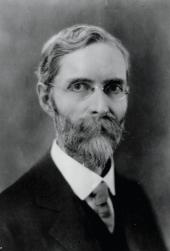
Sir Charles Edward Saunders was born in London, Ontario on February 2, 1867. He graduated from the University of Toronto, and received a PhD from Johns Hopkins University in 1891. In 1893 he and his wife, Mary Blackwell, ran a music school and wrote a music column in The Week magazine. Unable to earn a living, he moved to Ottawa in 1902 to accept an appointment from his father William at the Central Experimental Farm. It was under William Saunders' direction that experimental farms were established in Canada. In 1904 Charles Saunders discovered Marquis, a strain of wheat that matured seven to ten days earlier than other varieties - in particular Red Fife, which was the main variety at that time. Marquis had good milling qualities and became the standard for other wheat varieties. The Marquis wheat was tested in Saskatchewan and Manitoba from 1907 to 1909, and did extremely well.
By 1920 over 90% of the 17 million acres of wheat in western Canada were Marquis. The introduction of this hardy early-ripening wheat allowed farmers to grow the crops further north, doubling the amount of arable land on the prairies, and was responsible for the reputation Canada gained for producing the best hard spring wheat in the world. In 1921, Saunders was made Fellow of the Royal Society of Canada and received an honorary LLD degree from the University of Western Ontario. Due to ill health, he moved to France in 1922. In 1925 he was awarded the Flavelle Medal for Science from the Royal Society of Canada and an honorary doctorate from the University of Toronto. In gratitude to Saunders, Canadian farmers independently raised funds to increase his annual pension from $900 to $5,000 a year. In 1934 he was knighted by King George V. In recognition of his work with the French language as a writer and connoisseur, he was made Officier de l'instruction publique and Médaillé de l'Académie française by the French Government. Saunders died on July 25, 1937.
Daria Coneghan